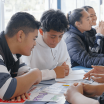Design assessments to enable students to demonstrate their understanding
Suggestion for implementing the strategy ‘Planning using UDL in primary settings’
On this page:
On this page:
Current page section: Design assessments to enable students to demonstrate their understanding
Go to top of current page: Design assessments to enable students to demonstrate their understanding
Go to top of current page: Design assessments to enable students to demonstrate their understanding
Go to top of current page: Design assessments to enable students to demonstrate their understanding
Design assessments with UDL
Design assessments with UDL
The important thing about getting an accurate assessment is to universally design it and make sure that we’re actually measuring what we’re hoping to measure,
so to do that we have to use alternatives, multiple assignments, multiple forms of a test so that every student gets a fair and accurate assessment.
Minimise threats and barriers
Minimise threats and barriers
Tyler describes his relief at being able to express his understanding.
Consider potential barriers
Consider potential barriers
- text-heavy assessments
- multiple choice assessments (paper-based or online)
- online assessments
- time restrictions
- prescribed writing tools (handwriting ot typing)
- unfamiliar layout
- length of assessment
- size and organisation of spaces and boxes to record in
- printed assessment.
Options for expressing learning
Options for expressing learning
Offer a range of flexible options for students to show what they know through:
- student portfolios
- systems where students are involved in keeping tack of their own learning
- self assessments
- peer assessments
- surveys
- checklists and regular check in times
- journals and learning stories
- video or audio recordings.
Reflection questions
Reflection questions
Consider the following questions in your own context.
- How do I evaluate the knowledge and skills that are directly related to learning goals and expectations?
- What processes do I use to ensure assessments are accessible, flexible, ongoing, and used to inform teaching and learning?
- How do I provide multiple means for students to express their thinking?
- Do I co-construct assessments with students whenever possible?
- Do I ensure students are supported with the tools and approaches they need to be successful (text-to-speech, Reader and/or Writer, digital version, additional time)?
Source: Adapted from CAST UDL curriculum self-check (opens in a new tab/window)
Useful resources
Useful resources

Top 10 UDL tips for assessment
A assessment resource published by CAST, the Center of Assistive Technologies. It provides suggestions and questions on how can you use the UDL framework to design and reflect on assessments. This resource can be downloaded as a PDF.

Know students better: 15 tools for formative assessments
Read time: 21 min
A selection of digital formative assessment tools that can be used for free. Tony Gear has written about 15. Most of these tools work with any web browser, so they can be used on laptops, iPads, Chromebooks, tablets, and smartphones.
Publisher: Learning in Hand
Next steps
More suggestions for implementing the strategy “Design considerations in primary settings”:
-
Current page Design assessments to enable students to demonstrate their understanding
Return to the guide “Universal Design for Learning”

How to use this site
Guide to Index of the guide: Universal Design for Learning
Understand:
- Why UDL is valuable
-
Find out about UDLShow suggestions for Find out about UDL
Strategies for action:
-
Design multiple means of EngagementShow suggestions for Design multiple means of Engagement
-
Design multiple means of RepresentationShow suggestions for Design multiple means of Representation
-
Design multiple means of Action and ExpressionShow suggestions for Design multiple means of Action and Expression
-
How to plan using UDLShow suggestions for How to plan using UDL
-
Design considerations in primary settingsShow suggestions for Design considerations in primary settings
- Prepare environments for flexibility
- Refine and support goal setting
- Match teaching methods to student preferences
- Ensure materials are flexible and accessible
- Design assessments to enable students to demonstrate their understanding
-
Design considerations in secondary settingsShow suggestions for Design considerations in secondary settings
-
Design considerations in NCEA assessmentsShow suggestions for Design considerations in NCEA assessments
